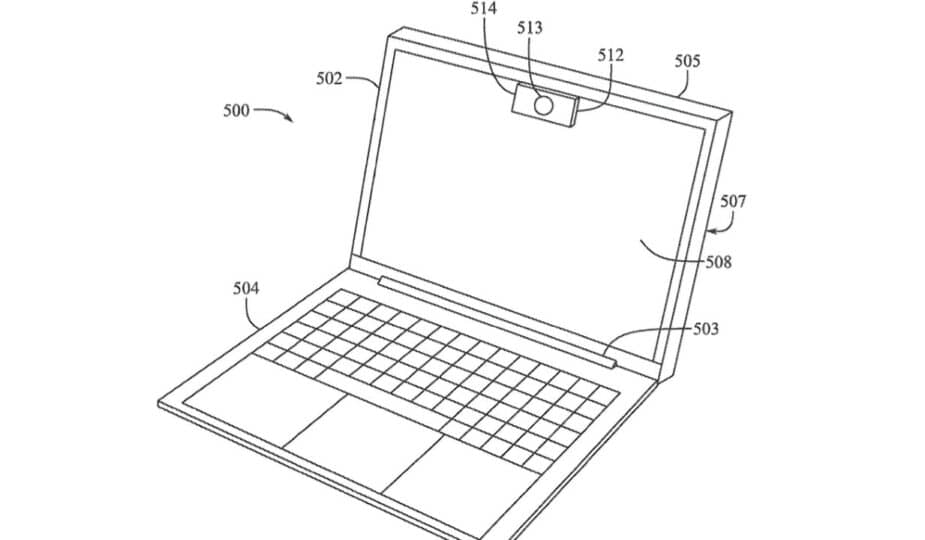The notch can be replaced with a protruding camera, but it can also be moved
 0 Facebook x.com Reddit
0 Facebook x.com Reddit
Last updated 18 hours ago
The FaceTime camera on the MacBook Pro is notoriously not as good as the one on the iPhone, but new research suggests Apple is still working on it and may have decided the answer is to fit larger cameras into a rotating display.
You might not think much of the camera cutout on the MacBook Pro. But even if you hate it and think it wastes screen space, the one thing you can't say is that it's thick.
It's pretty wide, wide enough to make you wonder why it doesn't include Face ID yet. But it doesn't add any extra thickness to the MacBook Pro's lid, and it's possible that it's that thickness that limits how good a camera system Apple can fit in there.
Rather than necessarily waiting until it can make thinner components, Apple is exploring the possibility of going another route. A recently filed patent application titled “Camera Integration for Portable Electronic Devices” completely ignores the effort to make the device thin, and instead focuses on providing the camera system needed for the MacBook Pro.
What’s more, while this is a new patent application, it’s not a new idea. As Apple has already been granted a patent with the same title and at least on the same topic in July 2024.
It’s not uncommon for Apple to refile a patent, and all that could really mean is that the company is sticking with an idea.
In this particular case, the idea’s drawings suggest that the new camera system would be no more than 3mm thick. And it would definitely protrude from the lid of the MacBook Pro.
The obvious question is how wide that protrusion would be, but then the less obvious question is where it would be located. In many of its patent drawings, Apple specifies that it is “at least partially positioned within a recess defined by the display assembly.”
But in other cases, what’s called a “second camera module” could be moved to one side of the screen. Or it could even be removed from the front and attached to the back.
Apple's patent application, which appears to use magnets, describes an “optical component” that attaches to the “wall” (or lid) of the MacBook Pro. “The optical component may be configured to be removable and attachable to a wall via a locking component,” it says, “and removable and attachable to a display assembly via a locking component.”
There are multiple references to the camera module being able to interact with other such modules. In a key example, one camera protrudes from the front of the display facing the user, while another protrudes from the back.
The notch is gone, but it's been replaced by a much larger camera
It's hard to imagine this being a viable video conferencing system when some participants are looking at the display and some are not. Any improvement in angle adjustment for the user at the keyboard should make the cropping incorrect for people behind it.
However, with the short distance between the MacBook and the people being filmed by the camera, it could resemble the promise of the iPhone 11. While it’s ultimately limited to HD and therefore less usable than Apple claimed, this iPhone could shoot video from both the front and rear cameras at the same time.
The camera module could be attached to the back of the MacBook Pro’s display.
Perhaps a MacBook with two such camera modules could be used for this. Or perhaps a single camera module on the back of the MacBook Pro could film the interviewee, while the interviewer simply used the built-in FaceTime camera.
However, there’s another proposal in this new patent that, at first glance, seems like a revolutionary step — literally.
“The portable electronic device may include a base portion including an input component, a display portion rotationally attached to the base portion,” the patent says.
So a user could mount one of these additional camera models on the back of the MacBook Pro lid, and then rotate the entire display when they want to be filmed. Or mount it on the front and rotate the display when they want to use the camera module’s LiDAR sensor, for example.
Unusually for a patent, this patent also doesn’t focus on what the rotation would be useful for, or how it would be achieved. Its purpose is to mount protruding camera or sensor modules, and the descriptions of the rotation concern what area of the display would be visible.
Even a conventional hinged display is a bit of an electronic marvel, and tension on the flexible cables has always been a problem. But that may not be the case anymore, since a rotating display doesn’t need to run cables around its axis — it could be a wireless display.
If such a display were like Sidecar, that would also make the patent’s latest display idea possible.
The display portion could be rotated, or perhaps even removed, turned around, and put back in place.
The patent application suggests that instead of rotating around an axis or hinge, the MacBook Pro display could be removed from the device and moved. So the lid could be detached from the keyboard area, turned around, and put back in place.
Once you do that, you increase the potential for screens or keyboard units that are somehow customizable to suit different needs. But that’s not what this application is looking at.
The patent application is credited to four inventors, including Keith J. Hendren, whose previous work includes research into creating an iMac from a single sheet of glass.
Follow AppleInsider on Google News









